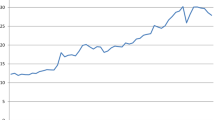Abstract
Despite the countless publications on the subject, globalization remains a black box. On the descriptive level, there is relative consensus as to the facts, but the meaning is not truly understood. As a result, extremely contradictory hypotheses circulate, ranging from the `end of geography' the global village and the borderless `global company' to those who highlight the development of territorialized forms of production and the role of proximity. This article brings out the different ways of viewing this phenomenon and their consequences. The main rift between the different approaches is between `homogenizing' approaches and `particularizing' approaches. The former postulate that any phenomenon may be viewed within a `universal' scheme that is `a priori' deemed sufficient to explain reality, while the latter are based on the irreducible singularity of each case and propose constantly evolving explanatory schemas.
Similar content being viewed by others
References
Amin A. and Robins K., 1991: These are not Marshallian times. In: Camagni R. (ed.), Innovation Networks: Spatial Perspectives. Pinter, London, pp. 105-118.
Astley G., 1985: The two ecologies: population and community perpectives on organizational evolution. Administrative Science Quarterly 30: 224-241.
Aydalot P., 1986: Milieux Innovateurs en Europe. GREMI, Paris.
Bailly A. and Coffey W. 1994: Regional Science in crisis: a plea for a more open and relevant approach. Papers in Regional Science 71: 3-14.
Becattini G., 1990: The marshallian industrial district as a socio-economic notion. In: Pyke F. et al. (eds), Industrial Districts and Inter-Firm Cooperation in Italy. Bureau international du travail, Genève, pp. 37-51.
Benko G., 1995: Les théories du développement local. Problèmes économiques 2440: 22-27.
Camagni R. and Rabellotti R., 1997: Footwear production systems in Italy: A dynamic comparative analysis. In: Ratti et al. (eds), The Dynamics of Innovative Regions. Ashgate and GREMI, London, pp. 139-163.
Chesnais F., 1994: La mondialisation du capital. Paris: Syros, coll. Alternatives économiques.
Coomans G., 1995: Les tentations de l'économie académique. Economie appliquée 4: 177-214.
Colletis G. and Pecqueur B., 1995: Politiques technologiques locales et création de ressources spécifiques. In: Rallet A. and Torre A. (eds), Economie industrielle et économie spatiale. Economica Paris, pp. 445-463.
Courlet C. and B. Pequeur, 1992: Les systèmes industriels localisés en France: un nouveau modèle de développement. In: Benko G. et Lipietz A. (eds), Les régions qui gagnent PUF, Paris, pp. 81-102.
Crevoisier O., 1990: Functional logic and territorial logic and how they inter-relate in the region. In: Cicioti E et al. (eds), Technological Change in a Spatial Context. Berlin, Springer-Verlag, pp.
Crevoisier O., 1993a: Industrie et régions: les milieux innovateurs de l'Arc jurassien. EDES, Neuchâtel.
Crevoisier O., 1993b: Spatial shifts and the emergence of innovative milieux. Environment and Planning C: Government and Policy 11: 419-430.
Crevoisier O. et al., 1996: La dynamique des savoir-faire. Seismo, Zürich.
Crevoisier O. and Camagni R. 2000: Les milieux urbains: innovation, système de production et ancrage. Survey GREMI V, Neuchâtel: EDES et GREMI.
Dicken P., 1992: Global Shift. 2nd edn. Paul Chapman Publishing, London.
Garfoli G., 1983: Industrializzazione diffusa in Lombardia. Franco Angeli Editore, Milan.
Garfoli G., 1992: Les systèmes de petites entreprises: un cas paradigmatique de développement endogène. In: Benko G. et Lipietz A. (éds), Les régions qui gagnent. PUF, Paris, pp. 58-80.
Garfoli G., 1993: New firm formation and regional development: the italian case. Regional Studies 28: 381-393.
Harrison B., 1994: Lean and Mean: The Changing Landscape of Corporate Power in the Age of Fexibility. Basic Books, New York.
Johansson B. et al., 1994: Patterns of a Network Economy. Springer-Verlag, Berlin.
Krugman P., 1991: Geography and Trade. Leuven University Press and MIT Press, Leuven.
Maillat D. and Perrin J.-C. (éds.), 1992: Entreprises innovatrices et réseaux locaux. EDES, Neuchâtel.
Maillat D. et al. (éds), 1993: Nouvelles formes d'organisation industrielle: réseaux d'innovation et milieux locaux. Editions de la Division économique et sociale, Neuchâtel.
Maillat D. and Kebir L. 1999: Learning regions et systèmes territoriaux de production. Revue d'économie régionale et urbaine 3: 429-448.
Myrdal G., 1957: Economic Theory and Underdevelopped Regions. Duckworth, London.
O'Brien R., 1992: Global Financial Integration: The End of Geography. Pinter Publisher, London.
OECD, 1993: Développement territorial et changement structurel. OECD, Paris.
Piaget J., 1977: Introduction: l'épistémologie des régulations. In: Lichnerowicz et al. (éds), L'idée de régulation dans les sciences Maloine-Doin, Paris, pp. I-XIII.
Piore M. and Sabel Ch., 1984: The Second Industrial Divide. Basic Books, New York.
Raillet A. and Torre A., 1995: Introduction. In: Rallet A. et Torre A. (éds), Economie industrielle et économie spatiale. Economica, Paris, pp. 3-37.
Ratti R. et al. (eds.), 1997: The Dynamics of Innovative Regions. Ashgate and GREMI, London.
Schumpeter J., 1935: Théorie de l'évolution économique. Dalloz, Paris.
Storper M., 1991: The limits to globalization: Technology districts and international trade. Economic Geography 1: 29-54.
Thireau V., 1993: Les nouvelles dynamiques spatiales: à la redécouverte des territoires. L'Harmattan, Paris.
Varela F., 1989: Autonomie et connaissance. Le Seuil, Paris.
Author information
Authors and Affiliations
Rights and permissions
About this article
Cite this article
Crevoisier, O. Two ways to look at learning regions in the context of globalization: The homogenizing and particularizing approaches. GeoJournal 49, 353–361 (1999). https://doi.org/10.1023/A:1007163527210
Issue Date:
DOI: https://doi.org/10.1023/A:1007163527210




